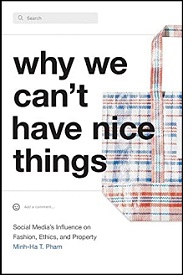Professor Minh-Ha T. Pham Talks Social Media, Ethical Fashion, What “Made in Italy” Means
by Debra Lau Whelan
 Ethical fashion is more than just a buzzword. It translates into big bucks for the $3 trillion global fashion industry. And as Minh-Ha T. Pham explains in her book, “Why We Can’t Have Nice Things”, social media influencers now play a huge role in calling out copycat retailers and their unscrupulous ways. Pham, an associate professor in the graduate program in media studies at the Pratt Institute, refers to this fashion policing as “crowdsourcing IP (intellectual property) regulation.” While these influencers are well-intentioned, Pham’s book argues that online fast-fashion shaming ironically perpetuates the racist idea that Asians lack originality and that creativity lies solely in the West.
Ethical fashion is more than just a buzzword. It translates into big bucks for the $3 trillion global fashion industry. And as Minh-Ha T. Pham explains in her book, “Why We Can’t Have Nice Things”, social media influencers now play a huge role in calling out copycat retailers and their unscrupulous ways. Pham, an associate professor in the graduate program in media studies at the Pratt Institute, refers to this fashion policing as “crowdsourcing IP (intellectual property) regulation.” While these influencers are well-intentioned, Pham’s book argues that online fast-fashion shaming ironically perpetuates the racist idea that Asians lack originality and that creativity lies solely in the West.
 So how did Pham, a refugee who fled Vietnam with her family during the fall of Saigon, end up a researcher of fashion, globalization, capitalism, and labor? She credits her mother, a talented dressmaker, who would visit shops, turn garments inside out to study their designs, and then head home to recreate them herself. Pham turned her love of fashion into an intellectual pursuit after earning a PhD in ethnic studies at UC Berkeley.
So how did Pham, a refugee who fled Vietnam with her family during the fall of Saigon, end up a researcher of fashion, globalization, capitalism, and labor? She credits her mother, a talented dressmaker, who would visit shops, turn garments inside out to study their designs, and then head home to recreate them herself. Pham turned her love of fashion into an intellectual pursuit after earning a PhD in ethnic studies at UC Berkeley.
Something like 30% of the factories in Prato are Chinese owned and operated. They moved those factories to Italy precisely so they could use the “Made in Italy” label even though Asian or immigrant women make these products. The “Made in Italy” label works to whiten or deracialize that labor.
There was a 2015 exhibit at the Met called China: Through the Looking Glass. No one there was accused of stealing Asian designs.
How do you define “ethical fashion”?
What’s the difference between cultural appreciation and appropriation, and is the latter ever OK?
The appreciation/appropriation question often turns on this idea of respect and disrespect, but often western designers and consumers doing the appropriating or appreciating get to define these categories--not the group whose designs are being copied. So the appreciation/appropriation question ultimately isn't that useful. It's much more interesting to follow the money. Who is profiting from the use of this Indigenous or racially marked design? What do source communities get? Did they get credit? Did they get compensation? If they didn't, then does it matter how appreciative the designer says they are?
Your book talks about the Vancouver-based knitwear company, Granted Clothing, calling out Forever 21 for copying its hand-knit Cowichan designs. But who’s calling out Granted for stealing that design from the indigenous Coast Salish women?
 A few people did call out Granted but they were certainly in the minority. And it's not because Granted and its supporters are bad people. My book is concerned with the racial blind spots in ethical fashion discourse and the debates about creativity and copying. What this book demonstrates is that while this IP crowdsourcing towards ethical fashion might be well-intentioned, they’re actually trafficking in racist and colonial ideas about who is an originator and who was always a fake--and where does originality and imitation come from in terms of people and places.
A few people did call out Granted but they were certainly in the minority. And it's not because Granted and its supporters are bad people. My book is concerned with the racial blind spots in ethical fashion discourse and the debates about creativity and copying. What this book demonstrates is that while this IP crowdsourcing towards ethical fashion might be well-intentioned, they’re actually trafficking in racist and colonial ideas about who is an originator and who was always a fake--and where does originality and imitation come from in terms of people and places.
Fashion consumers and social media users--that is to say, all of us--are becoming complicit in aiding and abetting a global industry. These brands extract not only labor from the global south, but we also see them extracting designs, aesthetics and, even design practices as appropriate for themselves and making money off of it -- and now we use our voices and our social media accounts to help them justify these practices, all in the name of being "ethical."
Can you define crowdsourcing IP (intellectual property) regulation?
It’s a phenomenon that is also known as social media shaming or online fashion policing. It used to be the exclusive job of IP lawyers and border agencies to regulate intellectual property in trade. But social media users are now taking on these tasks, and in some cases, brands are asking or recruiting them to call out fake fashion.
Can you elaborate on how crowdsourcing IP perpetuates racist and colonial ideas?
These cultural stereotypes actually determine value in a global industry that's worth about $3 trillion. [It promotes] the idea that creativity and originality live in the U.S. and Europe, while Asia and parts of Africa become places where there are only fakers and imitators. That [explains] why we expect to pay very little for things made in Asia. But if it's made or designed in Brooklyn or New York, then it justifies a higher price tag. So the directions in which capital flows and who it flows to is linked to these cultural ideas.
So social media has created a new line of work in the fashion world?
Consumers are being recruited to do unpaid labor for fashion brands, which no longer have to pay lawyers or court fees. What might have taken designers months to pull a design off the shelves now takes days once people start boycotting. Social media users and consumers are doing what the law doesn't do--provide property protections to something that in most cases isn’t considered property.
Is it illegal to steal fashion design ideas?
In the United States, fashion design, for all intents and purposes, is not protected. You can trademark logos, you can copyright details that are purely ornamental, like a plate, a particular style of a buckle, or the red sole of a shoe. You can copyright details that are not functional to the garment, but you can’t copyright the design or shape of a garment, like a pant leg.
Who’s receiving the brunt of the shame for buying unethical fashion?
They’re shaming the brand and the retailer, but they're also shaming consumers. So if you bought that Forever 21 sweater, then you're part of the problem. Much of this shaming moves in the direction of fast fashion shaming, so we blame fashion consumers for shopping at Zara or Forever 21 for trendy clothes, when they have the least amount of power in the end.
 How effective is this shaming and does it really stop people from buying these brands?
How effective is this shaming and does it really stop people from buying these brands?
My students tell me they're ashamed of their friends or of themselves for having bought something from Forever 21 or H&M. But buying something from Prada or Louis Vuitton sort of removes them from the system of exploitation. People and students have told me that when they buy something from H&M, they try to hide the bag in a larger tote bag. Fast fashion shaming perpetuates the idea that there's some moral virtue that comes with buying designer and luxury fashions.
People might hide it, but they’re clearly still buying it.
We all want a discount and a good deal. But because we have normalized the idea about where fake fashion and real fashion live and who makes them, we’re shoring up the historical, structural, racial, and geopolitical dynamics that the global industry has always relied on.
What impact does this have on the fashion industry?
There's a racial stigmatization of buying cheaper brands, and it’s terrible because it's a form of class shaming. But it also lets luxury brands and consumers off the hook. “As long as I buy Stella McCartney, then I'm okay.” Ironically, because the fast and budget fashion retailers and designers have gotten so much media scrutiny, their labor conditions are much better than the luxury brands. But nobody pays attention because there's still an assumption that a higher price means a higher standard of production and a higher quality product.
How do you change this way of thinking?
There is a history of racializing Asians as uncreative people who are good at taking directions and good middle managers, but never the boss. We see this a lot in cooking competitions when the judges say the Asian chef is technically great but their food has no soul. It’s a way of dehumanizing Asians as being technically good workers, who will work hard and are good at repetitive and so uncreative work. This is the same racial logic that justifies why garment workers or other Asian workers get paid so little--because the work they do is considered unskilled labor and certainly not creative work.
I’m sure Asian designers start to internalize all of these negative stereotypes.
Some designers, fashion magazine editors, and writers talk about how the [Asian] design industry is growing and maturing--as if they were children who needed to grow up--and the West was the more advanced culture with more advanced design centers. We absolutely do internalize that. A lot of Asian designers emulate Western designers. There’s a reason why they're coming to fashion school at Parsons, Pratt, and FIT in New York City because even having the degree from a U.S. institution or England is more meaningful and itself a form of capital.
Social media is a very heterogeneous space, and there are voices pushing back against the kind of colonial racist property logics that get used when we talk about fake fashion. But they're still in the minority.
Dolce & Gabbana got that push back in 2018 when it ran racist ads prior to a huge Shanghai fashion show.
In this case, [D&G] was having a huge show in China, and they were being racist. The response from ordinary customers who were using their voices on social media platforms was, “We're not going to take it.” Something was way more important to them than just the design and the designer. And if the designers were racist, then they didn’t want anything to do with them. Again, this is about following the money. It hurt Dolce & Gabbana financially and in terms of its branding.
It was an expensive mistake. D&G had to cancel its $23 million fashion show.
That's an exception, unfortunately. A lot of times that doesn't happen. But Chinese consumers are now a very powerful market. Economics plays a large role in how these conversations happen and which social media campaigns go viral and which don't
Do you think the negative stereotype of Asian fashion will lessen as China becomes more economically powerful?
I think so. Our iPhones and a lot of personal technologies are made in China. People line up around the block to get the latest iPhone at the [New York] Soho Apple store, so it's already changing. Miuccia Prada came out and said, “Yes, I make my stuff in China because it's good, because they know what they're doing.” There are more big name designers saying these kinds of stereotypes are ridiculous. But as the Chinese fashion design industry grows, the larger global perception in China will change. .
